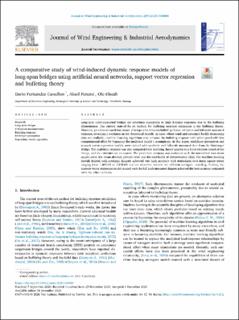| dc.contributor.author | Fernandez Castellon, Dario Rafael | |
| dc.contributor.author | Fenerci, Aksel | |
| dc.contributor.author | Øiseth, Ole Andre | |
| dc.date.accessioned | 2022-03-02T08:53:34Z | |
| dc.date.available | 2022-03-02T08:53:34Z | |
| dc.date.created | 2021-05-10T12:27:55Z | |
| dc.date.issued | 2021 | |
| dc.identifier.citation | Journal of Wind Engineering and Industrial Aerodynamics. 2021, 209 1-23. | en_US |
| dc.identifier.issn | 0167-6105 | |
| dc.identifier.uri | https://hdl.handle.net/11250/2982317 | |
| dc.description.abstract | Long-span cable-supported bridges are structures susceptible to high dynamic responses due to the buffeting phenomenon. The current state-of-the-art method for buffeting response estimation is the buffeting theory. However, previous research has shown discrepancies between buffeting theory estimates and full-scale measured response, revealing a weakness in the theoretical models. In cases where wind and structural health monitoring data are available, machine learning algorithms may enhance the buffeting response estimation speed with less computational effort by bypassing the analytical model’s assumptions. In this paper, multilayer perceptron and support vector regression models were trained with synthetic and full-scale measured data from the Hardanger Bridge. The analytical response was also computed from buffeting theory applied to a finite element model of the bridge, and the estimates are compared. The prediction accuracy was evaluated with the normalized root mean square error, the mean absolute percent error and the coefficient of determination (R2). The machine learning models trained with synthetic datasets achieved very high accuracy with normalized root mean square errors ranging from 1.46E-04 to 7.21E-03 and are therefore suitable for efficient surrogate modeling. Further, the support vector regression model trained with the full-scale measured dataset achieved the best accuracy compared with the other methods. | en_US |
| dc.language.iso | eng | en_US |
| dc.publisher | Elsevier | en_US |
| dc.rights | Navngivelse 4.0 Internasjonal | * |
| dc.rights.uri | http://creativecommons.org/licenses/by/4.0/deed.no | * |
| dc.title | A comparative study of wind-induced dynamic response models of long-span bridges using artificial neural networks, support vector regression and buffeting theory | en_US |
| dc.type | Journal article | en_US |
| dc.type | Peer reviewed | en_US |
| dc.description.version | publishedVersion | en_US |
| dc.source.pagenumber | 1-23 | en_US |
| dc.source.volume | 209 | en_US |
| dc.source.journal | Journal of Wind Engineering and Industrial Aerodynamics | en_US |
| dc.identifier.doi | 10.1016/j.jweia.2020.104484 | |
| dc.identifier.cristin | 1909151 | |
| cristin.ispublished | true | |
| cristin.fulltext | original | |
| cristin.qualitycode | 1 | |

